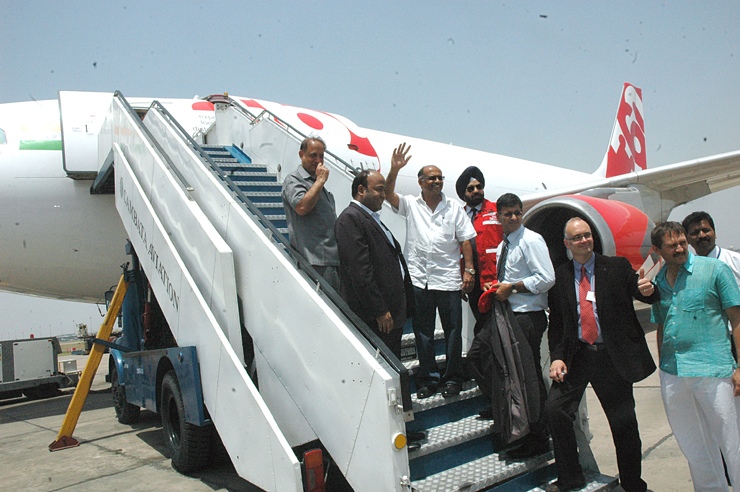You Say Goodbye I Say Hello

Happier times as Captain Gopi launched Deccan 360 freighters
sporting the company's distinctive red logo.
|
Is it curtains for Captain
G. R. Gopinath’s all cargo carrier Deccan 360?
After all the hype that Deccan 360, also
known as Deccan Cargo & Express Logistics, would be the next FedEx
of India, the pioneer of India’s low-cost aviation is floundering.
Reason? No finances.
The good captain—he is the Chairman
and Managing Director of Deccan 360—has had to give back the planes
he received on lease from the Mauritius-based Veling.
The three Airbus 310s that had been converted
to freighters were—according to those in the know—forcibly
taken away for non-payment of dues.
The Deccan 360 chief, however, maintained
that the planes were given back to the company.
Indeed, they had been taken on lease for
three years, but Deccan 360 needed smaller planes.
“So we returned them and purchased
ATRs,” he said.
Efforts to contact Deccan 360 or Capt.
Gopinath failed as no one was willing to take calls.
Veling is rated in the Top 40 Aircraft
Lessors Worldwide and is engaged in aircraft leasing and sales.
According to its website, the company
has concluded more than 20 successful transactions, including aircraft
sales and leases of both narrow and widebody aircraft worldwide.
The company has a long association with
India; in addition to the planes it had leased to Deccan 360, it conducted
its first sale to Air India with a lease attachment of five A310s; it
introduced seven CRJs for the erstwhile Air Sahara and owns two 2007-built
ATR72-500 aircraft leased to Kingfisher Airlines.
The grounding of Deccan 360 comes barely
a year after its launch.
The cargo airline started with quite an
impressive fleet of three Airbus 310s and five ATRs.
While the 310s touched the metros and
important cities, the ATRs flew to the smaller towns.
The aircraft, along with a whopping 1,000
vehicles, touched 50 centers in the country.
 ACNFT
readers will remember that around a year ago, Reliance Industries Limited’s
(RIL) chief (and the country’s richest man), Mukesh Ambani, (left)
had joined hands with Capt. Gopinath and taken a stake in Deccan 360. ACNFT
readers will remember that around a year ago, Reliance Industries Limited’s
(RIL) chief (and the country’s richest man), Mukesh Ambani, (left)
had joined hands with Capt. Gopinath and taken a stake in Deccan 360.
Without revealing the quantum of investment,
though it was somewhere between 25 and 50 percent, RIL said that the
finances would provide “growth capital” for the new cargo
airline.
The tie-up—if one may term it that—was
tomtomed to change logistics in the country. Mukesh Ambani had then
said:
“We believe that our collaboration
with Deccan 360 will see a transformation in the logistics domain in
India.”
Logistics pundits had commented that the
investment by Ambani would enable Deccan 360 to enhance its network
across the country and Capt Gopi had said that “Deccan 360's strategic
partnership with Reliance will enable us to realize our dream of creating
world class logistics reach to every nook and corner of India faster.”
The collaboration would turn out to create
a win-win situation for both.
Reliance, with its retail outlets in 200+
cities around the country, could take advantage of a dedicated cargo
service, and the investment would allow Deccan 360 to grow and consolidate
its position.
A few months ago Capt. Gopi had told an
interviewer that “Mukesh Ambani has a vision that Deccan 360 should
be better than world class in the cargo business and that's the kind
of vision which inspires us all to forge ahead.”
He also pointed out in the same interview
that he had no plans of “rebranding Deccan 360. I am a person
who enjoys creating new things, so I am not going to sell something
only for money.”
Though Reliance had two representatives
on the Deccan 360 board, the day-to-day operations were left to Capt.
Gopinath and his team.
The infusion of finances from Reliance
obviously did not help the sagging airline to revive its fortunes.
As news reached Ambani’s office
that the planes were taken away, the Reliance top brass said they were
thinking of withdrawing from the venture and divesting their stake.
Deccan 360’s present CEO, H. L.
Rikhye, said that Reliance officials had indicated that they were not
keen to invest in Deccan 360, but were “morally and otherwise
supportive of the business venture.”
It is now apparent that Deccan 360 could
not deliver what it promised.
While launching the airline, Capt. Gopi
had said that if India wanted become an economic powerhouse, opportunities
and markets have to spread across every part of the country: from the
metros to the smallest towns.
He said that “unlike the West or
nations such as China, India’s manufacturers in smaller cities,
traders in interior areas and farmers in villages are unable to compete
in the international market because of the limiting conditions of transportation
and connectivity.
“If, as a nation, we focus on infrastructural
development and include every one of the billion Indians to participate
in this revolution, air cargo and passenger traffic will show a strong
positive growth,” Gopinath pointed out on the Deccan 360 website.
He maintained that India needed to go
a long way before “we stake a claim to be called a developed nation.
“If you want to live in Chikmagalur
(a small town in Karnataka province),” wrote the captain, “you
should be able to stay there not only for your weekends, but also to
conduct your daily business with the facility of education, electricity,
roads, airports and Internet cafes.
“To achieve this dream, cargo connectivity
has to be embedded into the system - and that’s where Deccan 360
chips in.”
With the vision of providing a pan-India
service while enhancing supply chain and logistics operations, Deccan
360 needed funds as well as clients to expand. According to reports,
Deccan 360 had a whopping loss of Rs 120 crore last year.
The company had banked on large customers,
but what it got was small businesses.
While these small enterprises were certainly
not the high-yielding kind, they also did not provide regular business.
Add to that the fact that the company
has not had a leader to steer it – in fact, it has seen a number
of CEOs in its short life.
At the time of filing this report, word
from the Bangalore-headquartered Deccan 360 is that the company is not
folding up.
To begin with, Deccan 360 is cutting down
on a number of staffers and realigning its focus, which will now be
on international, non-scheduled cargo operations.
Charter cargo operations from international
markets is a growing business and Deccan 360 has found a number of opportunities
in that sector.
The blow from Reliance, however, is a
powerful one and could take the never-say-die Gopinath quite a while
to overcome.
Tirthankar Ghosh/Flossie |

